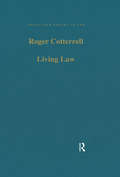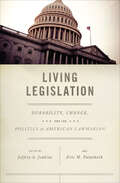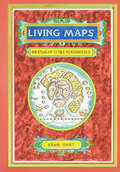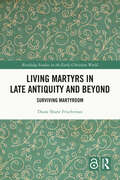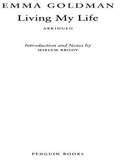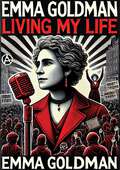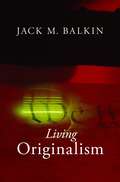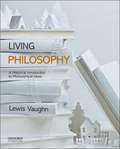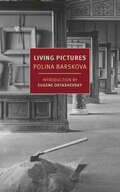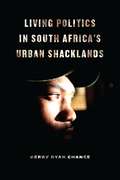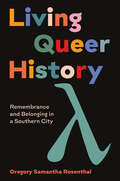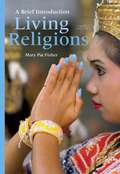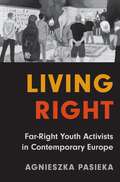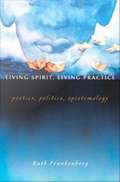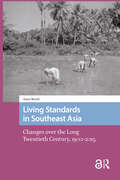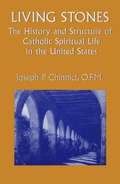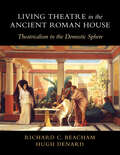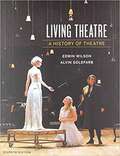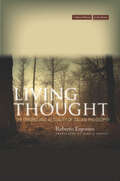- Table View
- List View
Living Law: Studies in Legal and Social Theory (Collected Essays In Law Ser.)
by Roger CotterrellLiving Law presents a comprehensive overview of relationships between legal and social theory, and of current approaches to the sociological study of legal ideas. It explores the nature of legal theory and sociolegal studies today as teaching and research fields, and the work of many of the major sociolegal theorists. In addition, it sets out the author's distinctive approach to sociological analysis of law, applying this in a range of studies in specific legal fields, such as the law of contract, property and trusts, constitutional analysis, and comparative law.
Living Legislation: Durability, Change, and the Politics of American Lawmaking
by William J. Novak Jeffrey E. Cohen David R. Mayhew William G. Howell Forrest Maltzman Matthew Eshbaugh-Soha Barry C. Burden Vesla M. Weaver Stuart Chinn Sidney M. Milkis Amihai Glazer Sean Gailmard David E. Lewis Charles R. Shipan Christopher R. BerryPolitical scholars examine the dynamic evolution of laws over time in a volume that &“pushes the frontiers of knowledge about lawmaking in the US&” (Choice). Politics is at its most dramatic during debates over important pieces of legislation. And while debates over legislative measures can rage for years or even decades before an item is enacted, they also endure long afterward, when the political legacy of a law eventually comes into focus. With a diverse set of contributors—including quantitative political scientists, political development scholars, historians, and economists—Living Legislation provides fresh insights into contemporary American politics and public policy. Many of the contributors to this volume focus on the question of why some laws stand the test of time while others are eliminated, replaced, or significantly amended. Others discuss how laws emerge from—and effect change within—coalition structures; the effectiveness of laws at mediating partisan conflicts; and the ways in which laws interact with broader shifts in the political environment. An essential addition to the study of politics, Living Legislation enhances understanding of democracy, governance, and power.
Living Like a Tudor: Woodsmoke and Sage: A Sensory Journey Through Tudor England
by Amy LicenceTake a 500-year journey back in time and experience the Tudor Era through the five senses.Much has been written about the lives of the Tudors, but it is sometimes difficult to really grasp how they experienced the world. Using the five senses, Amy Licence presents a new perspective on the material culture of the past, exploring the Tudors&’ relationship with the fabric of their existence, from the clothes on their back, roofs over their heads and food on their tables, to the wider questions of how they interpreted and presented themselves, and beliefs about life, death and beyond. This book helps recapture the past: what were the Tudors&’ favorite perfumes? How did the weather affect their lives? What sounds from the past have been lost? Take a journey back 500 years, to experience the Tudor world as closely as possible, through sights, sound, smell, taste and touch.
Living Maps: An Atlas of Cities Personified
by Adam DantVenture to twenty-eight cities around the world in this colorfully illustrated collection of maps that take you on a journey through history, culture, and geography.On each page, you’ll visit a different city. And in each city, you’ll explore the metaphorical resonance between the physical metropolis and its inhabitants, history, and culture. In the hands of a creative cartographer, Manhattan is dissected in an anatomical diagram, the streets of Monaco trace the form of a Picasso nude, and the crisscrossing paths of boats on the Bosphorus become the nerves of Istanbul.Travel as you never have traveled before, and revel in the details that define urban life. By laying bare the bone, muscle, and sinew of twenty-eight cities, these maps reveal the unique spirit of each one and shed light on the strange and marvelous ways in which humans interact with the places they call home.Witty and insightful, this book will capture the imaginations of travelers, map enthusiasts, history buffs, and dreamers.
Living Martyrs in Late Antiquity and Beyond: Surviving Martyrdom (Routledge Studies in the Early Christian World)
by Diane Shane FruchtmanThis book demonstrates that living martyrdom was an important spiritual aspiration in the late antique Latin west and argues that, consequently, attempts to define, study, or locate martyrdom must move away from conceptualizations that require or center on death. After an introduction that traces the persistence of "living martyrs" as real objects of spiritual devotion and emulation across the span of Christian history and discusses why such martyrs have been overlooked, the book focuses on three significant authors from the late ancient Latin west for whom martyrdom did not require death: the Spanish poet Prudentius (c. 348–413), the senator-turned-ascetic Paulinus of Nola (353–431), and the influential North African bishop Augustine of Hippo (354–430). Through historically and literarily contextualized close readings of their work, this book shows that each of these three authors attempted to create a new paradigm of martyrdom focused on living, rather than dying, for God. By focusing on these living martyrs, we are able to see more clearly the aspirations and agendas of those who promoted them as martyrs and how their martyrological discourse illuminates the variety of ways that martyrdom is and can be mobilized (in any era) to construct new, community-creating worldviews. Living Martyrs in Late Antiquity and Beyond is an important resource for historians of Christianity, scholars of religious studies, and anyone interested in exploring or understanding martyrological discourse. The Introduction of this book is available for free in PDF format as Open Access from the individual product page at www.routledge.com. It has been made available under a Creative Commons Attribution-Non Commercial-No Derivatives 4.0 license.
Living My Life
by Emma GoldmanAnarchist, journalist, drama critic, advocate of birth control and free love, Emma Goldman was the most famous—and notorious—woman in the early twentieth century. This abridged version of her two-volume autobiography takes her from her birthplace in czarist Russia to the socialist enclaves of Manhattan’s Lower East Side. Against a dramatic backdrop of political argument, show trials, imprisonment, and tempestuous romances, Goldman chronicles the epoch that she helped shape: the reform movements of the Progressive Era, the early years of and later disillusionment with Lenin’s Bolshevik experiment, and more. Sounding a call still heard today, Living My Life is a riveting account of political ferment and ideological turbulence. First time in Penguin Classics Condensed to half the length of Goldman's original work, this edition is accessible to those interested in the activist and her extraordinary era .
Living My Life: The Autobiography of a Social Activist, Women’s Rights Campaigner and Political Philosopher
by Emma GoldmanStep into the passionate and tumultuous world of one of history's most iconic anarchists with Emma Goldman’s powerful autobiography, "Living My Life." This riveting two-volume memoir offers an unflinching account of Goldman's life, from her early years in Russia to her rise as a leading figure in the anarchist movement in the United States and beyond.Emma Goldman, renowned for her fiery oratory and uncompromising activism, provides a deeply personal narrative that intertwines her political beliefs with her personal experiences. "Living My Life" chronicles her relentless fight for social justice, free speech, and workers' rights, painting a vivid picture of her involvement in pivotal historical events, including the Haymarket affair, the rise of the labor movement, and the fight for women's emancipation.Through Goldman's eloquent prose, readers gain insight into the challenges and triumphs she faced as a radical thinker and activist. She candidly discusses her relationships, her encounters with prominent figures like Alexander Berkman and Peter Kropotkin, and her multiple imprisonments and deportations. Goldman's reflections on her life's work provide a poignant look at the sacrifices and resilience required to pursue a vision of a more equitable world."Living My Life" is not just a historical document but also a testament to the enduring spirit of resistance and the quest for freedom. Goldman's narrative is imbued with a profound sense of humanity, capturing her unwavering dedication to her principles and her unyielding belief in the power of individual and collective action.This autobiography is essential reading for anyone interested in the history of social movements, anarchism, and feminist thought. Emma Goldman's "Living My Life" remains a compelling and inspirational work that continues to resonate with readers seeking to understand the complexities of social change and the indomitable will of those who fight for it. Immerse yourself in Emma Goldman’s extraordinary journey and discover the life of a woman who defied conventions, challenged injustices, and left an indelible mark on the world.
Living On: Psychiatry and the Future of Disaster in Turkey
by Christopher T. DoleLiving On centers around the unprecedented mobilization of mental health professionals in the wake of a massive earthquake that struck western Turkey in 1999—a disaster that left more than 20,000 people dead and hundreds of thousands of residents displaced. Working amid unimaginable destruction and suffering, volunteer psychiatrists and psychologists would quickly improvise a makeshift response, offering thousands of survivors access to psychiatric care for the first time. Never before had there been such a collective expression of concern for people's psychological well-being. Christopher Dole explores how this psychiatric response fashioned individual and collective lives far into the disaster's future. Based on research spanning two decades, from the earthquake to its twentieth anniversary, he considers how this convergence of geological activity and psychiatric expertise introduced novel psychiatric and psychological discourses into everyday lives of survivors, as it also animated new visions of self, society, and technopolitical promise. Living On not only offers insight into Turkey's transformations over the opening decades of the twenty-first century, but it also sheds light on a more general arrangement of disaster, governance, and medical expertise—one that increasingly characterizes our era of planetary ecological crisis.
Living Originalism
by Jack M. BalkinOriginalism and living constitutionalism, so often understood to be diametrically opposing views of our nation’s founding document, are not in conflict—they are compatible. So argues Jack Balkin, one of the leading constitutional scholars of our time, in this long-awaited book. Step by step, Balkin gracefully outlines a constitutional theory that demonstrates why modern conceptions of civil rights and civil liberties, and the modern state’s protection of national security, health, safety, and the environment, are fully consistent with the Constitution’s original meaning. And he shows how both liberals and conservatives, working through political parties and social movements, play important roles in the ongoing project of constitutional construction. By making firm rules but also deliberately incorporating flexible standards and abstract principles, the Constitution’s authors constructed a framework for politics on which later generations could build. Americans have taken up this task, producing institutions and doctrines that flesh out the Constitution’s text and principles. Balkin’s analysis offers a way past the angry polemics of our era, a deepened understanding of the Constitution that is at once originalist and living constitutionalist, and a vision that allows all Americans to reclaim the Constitution as their own.
Living Philosophy: A Historical Introduction to Philosophical Ideas
by Lewis VaughnThis second edition of Living Philosophy guides students in a survey of the historical march of philosophical ideas, encouraging an appreciation of the significance of these ideas in Western and Eastern thought. Living Philosophy provides this guidance in five fundamental ways: it tells a coherent story of philosophical thought from the pre-Socratics to the present; it provides the cultural and intellectual background for this story; it explains why the major issues and arguments are important and relevant today; it includes substantial, well-chosen excerpts from the philosophers' works; and it presents all these elements in a way that engages and stimulates student interest and understanding. Living Philosophy includes solid coverage of critical-thinking skills and argument basics as well as practice in reading philosophical works. Students learn how to do philosophy--to think and write philosophically--when they get encouragement and practice in analyzing and critiquing their own views as well as those philosophers they study. To this end, Living Philosophy emphasizes philosophical writing, reinforced with step-by-step coaching in how to write argumentative essays on philosophical topics and supported by multiple opportunities to hone basic skills. Living Philosophy further engages today's learners with abundant illustrations and graphics; marginal glosses, questions, and quotations; profiles of a diverse array of philosophers; and ample representation of non-Western and nontraditional sources and voices.
Living Pictures
by Polina BarskovaA poignant collection of short pieces about the author's hometown, St. Petersburg, Russia, and the siege of Leningrad that combines memoir, history, and fiction.Living Pictures refers to the parlor game of tableaux vivants, in which people dress up in costume to bring scenes from history back to life. It&’s a game about survival, in a sense, and what it means to be a survivor is the question that Polina Barskova explores in the scintillating literary amalgam of Living Pictures. Barskova, one of the most admired and controversial figures in a new generation of Russian writers, first made her name as a poet; she is also known as a scholar of the catastrophic siege of Leningrad in World War II. In Living Pictures, Barskova writes with caustic humor and wild invention about traumas past and present, historical and autobiographical, exploring how we cope with experiences that defy comprehension. She writes about her relationships with her adoptive father and her birth father; about sex, wanted and unwanted; about the death of a lover; about Turner and Picasso; and, in the final piece, she mines the historical record in a chamber drama about two lovers sheltering in the Hermitage Museum during the siege of Leningrad who slowly, operatically, hopelessly, stage their own deaths.Living Pictures introduces a startlingly daring and original new voice from world literature.
Living Pictures, Missing Persons: Mannequins, Museums, and Modernity
by Mark B. SandbergIn the late nineteenth century, Scandinavian urban dwellers developed a passion for a new, utterly modern sort of visual spectacle: objects and effigies brought to life in astonishingly detailed, realistic scenes. The period 1880-1910 was the popular high point of mannequin display in Europe. Living Pictures, Missing Persons explores this phenomenon as it unfolded with the rise of wax museums and folk museums in the largest cities of Denmark, Sweden, and Norway. Mark Sandberg asks: Why did modernity generate a cultural fascination with the idea of effigy? He shows that the idea of effigy is also a portal to understanding other aspects of visual entertainment in that period, including the widespread interest in illusionistic scenes and tableaux, in the "portability" of sights, spaces, and entire milieus. Sandberg investigates this transformation of visual culture outside the usual test cases of the largest European metropolises. He argues that Scandinavian spectators desired an unusual degree of authenticity--a cultural preference for naturalism that made its way beyond theater to popular forms of museum display. The Scandinavian wax museums and folk-ethnographic displays of the era helped pre-cinematic spectators work out the social implications of both voyeuristic and immersive display techniques. This careful study thus anticipates some of the central paradoxes of twentieth-century visual culture--but in a time when the mannequin and the physical relic reigned supreme, and in a place where the contrast between tradition and modernity was a high-stakes game.
Living Poetically: Kierkegaard's Existential Aesthetics (Literature and Philosophy)
by Sylvia WalshLiving Poetically is the first book to focus primarily on Kierkegaard's existential aesthetics as opposed to traditional aesthetic features of his writings such as the use of pseudonyms, literary techniques and figures, and literary criticism. Living Poetically traces the development of the concept of the poetic in Kierkegaard's writings as that concept is worked out in an ethical-religious perspective in contrast to the aesthetics of early German romanticism and Hegelian idealism. Sylvia Walsh seeks to elucidate what it means, in Kierkegaard's view, to be an authentic poet in the form of a poetic writer and to clarify his own role as a Christian poet and writer as he understood it. Walsh shows that, in spite of strong criticisms made of the poetic in some of his writings, Kierkegaard maintained a fundamentally positive understanding of the poetic as an essential ingredient in ethical and religious forms of life. Walsh thus reclaims Kierkegaard as a poetic thinker and writer from those who would interpret him as an ironic practitioner of an aestheticism devoid of and detached from the ethical-religious as well as from those who view him as rejecting the poetic and aesthetic on ethical or religious grounds.Viewing contemporary postmodern feminism and deconstruction as advocating a romantic mode of living poetically, Walsh concludes with a feminist reading of Kierkegaard that affirms both individuality and relatedness, commonalities and differences between the self and others, men and women, for the fashioning of an authentic mode of living poetically in the present age.
Living Politics in South Africa’s Urban Shacklands
by Kerry Ryan ChanceWhile much has been written on post-apartheid social movements in South Africa, most discussion centers on ideal forms of movements, disregarding the reality and agency of the activists themselves. In Living Politics, Kerry Ryan Chance radically flips the conversation by focusing on the actual language and humanity of post-apartheid activists rather than the external, idealistic commentary of old. Tracking everyday practices and interactions between poor residents and state agents in South Africa’s shack settlements, Chance investigates the rise of nationwide protests since the late 1990s. Based on ethnography in Durban, Cape Town, and Johannesburg, the book analyzes the criminalization of popular forms of politics that were foundational to South Africa’s celebrated democratic transition. Chance argues that we can best grasp the increasingly murky line between “the criminal” and “the political” with a “politics of living” that casts slum and state in opposition to one another. Living Politics shows us how legitimate domains of politics are redefined, how state sovereignty is forcibly enacted, and how the production of new citizen identities crystallize at the intersections of race, gender, and class.
Living Queer History: Remembrance and Belonging in a Southern City
by Gregory Samantha RosenthalQueer history is a living practice. Talk to any group of LGBTQ people today, and they will not agree on what story should be told. Many people desire to celebrate the past by erecting plaques and painting rainbow crosswalks, but queer and trans people in the twenty-first century need more than just symbols—they need access to power, justice for marginalized people, spaces of belonging. Approaching the past through a lens of queer and trans survival and world-building transforms history itself into a tool for imagining and realizing a better future. Living Queer History tells the story of an LGBTQ community in Roanoke, Virginia, a small city on the edge of Appalachia. Interweaving &8239;historical analysis, theory, and memoir, Gregory Samantha Rosenthal tells the story of their own journey—coming out and transitioning as a transgender woman—in the midst of working on a community-based history project that documented a multigenerational southern LGBTQ community. Based on over forty interviews with LGBTQ elders, Living Queer History explores how queer people today think about the past and how history lives on in the present.
Living Religions
by Mary FisherLiving Religions emphasizes the personal consciousness of believers and their own accounts of their religion and relevance in the present day. Mary Pat Fisher considers how the contemporary beliefs and practices of each of these traditions has evolved, and explores the changing nature of each religion. The ninth edition focuses on cultural customs, popular spiritual practices, mixtures of religions, and varieties of religions ways. Expanded coverage of women, including women's voices and contributions, is woven into the discussion of each religion. Living Religions provides a sympathetic approach to the historical teachings of traditional faiths, indigenous religions, and new religious movements. The text follows a clear and straightforward account of the development, doctrines, and practices of the major faiths followed today.
Living Religions: A Brief Introduction
by Mary Pat Fisher<p>Living Religions: A Brief Introduction 3/e presents a highly readable and stimulating concise survey of the modern religious world though an emphasis on the personal consciousness of believers and their own accounts of their religion and relevance in contemporary life. <p>Along with a team of specialist consultants in each faith, and drawing on a wealth of scholarly research and firsthand source material, Mary Pat Fisher provides a fresh and challenging insight into the historical development and teachings of traditional faiths, indigenous religions, and new religious movements. She considers how the contemporary beliefs and practices of each of these traditions has evolved, and explores the changing nature of each religion; particularly the role of women, and the issues and controversies such as fundamentalism, violence, globalization, and interfaith initiatives. </p>
Living Right: Far-Right Youth Activists in Contemporary Europe
by Agnieszka PasiekaA sobering look at the seductive power of fascist ideas for the youngRadical nationalism is on the rise in Europe and throughout the world. Living Right provides an in-depth account of the ideas and practices that are driving the varied forms of far-right activism by young people from all walks of life, revealing how these social movements offer the promise of comradery, purpose, and a moral calling to self-sacrifice, and demonstrating how far-right ideas are understood and lived in ways that speak to a variety of experiences.In this eye-opening book, Agnieszka Pasieka draws on her own sometimes harrowing fieldwork among Italian, Polish, and Hungarian militant youths, painting unforgettable portraits of students, laborers, entrepreneurs, musicians, and activists from well-off middle class backgrounds who have all found a nurturing home in the far right. Providing an in-depth account of radical nationalist communities and networks that are taking root across Europe, she shows how the simultaneous orientation of these groups toward the local and the transnational is a key to their success. With a focus on far-right morality that challenges commonly held ideas about the right, Pasieka describes how far-right movements afford opportunities to the young to be active members of tightly bonded comradeships while sharing in a broader project with global ramifications.Required reading for anthropologists and anyone concerned about the resurgence of far-right militancy today, Living Right sheds necessary light on the forces that have made the growing appeal of fascist idealism for young people one of the most alarming trends of our time.
Living Spirit, Living Practice: Poetics, Politics, Epistemology
by Ruth FrankenbergIn Living Spirit, Living Practice, the well-known cultural studies scholar Ruth Frankenberg turns her attention to the remarkably diverse nature of religious practice within the United States today. Frankenberg provides a nuanced consideration of the making and living of religious lives as well as the mystery and poetry of spiritual practice. She undertakes a subtle sociocultural analysis of compelling in-depth interviews with fifty women and men, diverse in race, ethnicity, national origin, class, age, and sexuality. Tracing the complex interweaving of sacred and secular languages in the way interviewees make sense of the everyday and the extraordinary, Frankenberg explores modes of communication with the Divine, the role of the body, the importance of geography, work for progressive social change, and the relation of sex to spirituality. Christians, Jews, Muslims, Buddhists, Hindus, and other practitioners come together here, speaking in terms both familiar and surprising. Whether discussing an Episcopalian deacon, a former Zen Buddhist who is now a rabbi, a Chicano monastic, an immigrant Muslim woman, a Japanese American Tibetan Buddhist, or a gay African American practicing in the Hindu tradition, Frankenberg illuminates the most intimate, local, and singular aspects of individual lives while situating them within the broad, dynamic canvas of the U. S. religious landscape.
Living Standards in Southeast Asia: Changes over the Long Twentieth Century, 1900-2015 (Transforming Asia)
by Anne BoothLiving Standards in Southeast Asia: Changes over the Long Twentieth Century, 1900-2015 examines changes in living standards across the ten countries of Southeast Asia (Indonesia, Malaysia, Singapore, Philippines, Thailand, Brunei, Myanmar, Vietnam, Cambodia and Laos) from the early years of the 20th century to the early 21st century. It covers both the last decades of the colonial period, the transition to independence and the decades from 1960 to the 2010s. The study uses a range of monetary and non-monetary indicators to assess how living standards have changed over time. It examines the outcomes in the context of debates about economic growth, inequality and poverty alleviation which began in the 1960s and 1970s, and continue to the present.
Living Stones: The History and Structure of Catholic Spiritual Life in the United States (2nd edition)
by Joseph P. ChinniciLiving Stones was written from the perspective of a historian who experienced the changes in the community from 1950 to 1970, and who observed, suffered, enjoyed, and asked the questions peculiar to that particular post-World War II generation. If one experience was uppermost, it was that many of the participants in those changes experienced not simply the loss of this or that aspect of Catholic self-identity and practice (e.g. abstinence on Friday, the collapse of particular devotions, an increasing pluralism in the interpretation of the Church's moral norms), but the dissolution of a structure of belief, the collapse of a home constructed out of abstract principles, and a "scholasticism of the heart."
Living Theatre in the Ancient Roman House: Theatricalism in the Domestic Sphere
by Hugh Denard Richard C. BeachamFor the Romans, much of life was seen, expressed and experienced as a form of theatre. In their homes, patrons performed the lead, with a supporting cast of residents and visitors. This sumptuously illustrated book, the result of extensive interdisciplinary research, is the first to investigate, describe and show how ancient Roman houses and villas, in their décor, spaces, activities and function, could constitute highly-theatricalised environments, indeed, a sort of 'living theatre'. Their layout, purpose and use reflected and informed a culture in which theatre was both a major medium of entertainment and communication and an art form drawing upon myths exploring the core values and beliefs of society. For elite Romans, their homes, as veritable stage-sets, served as visible and tangible expressions of their owners' prestige, importance and achievements. The Roman home was a carefully crafted realm in which patrons displayed themselves, while 'stage-managing' the behaviour and responses of visitor-spectators.
Living Theatre: A History of Theatre
by Edwin Wilson Alvin GoldfarbFocused on the cultural relevance of theatre. Written in an engaging style. Designed to be accessible to undergraduates. Living Theatre is the most popular text for theatre history courses. The Seventh Edition builds on these strengths with “Past and Present”―a NEW feature that focuses on connections between theatre’s long history and the practice of theatre today―and with a brilliant NEW design that highlights the beauty and excitement of the art of theatre.
Living Theravada: Demystifying the People, Places, and Practices of a Buddhist Tradition
by Brooke SchedneckAn illuminating introduction to the contemporary world of Theravada Buddhism and its rich culture and practices in modern mainland Southeast Asia.Theravada translates as &“the way of the Elders,&” indicating that this Buddhist tradition considers itself to be the most authoritative and pure. Tracing all the way back to the time of the Buddha, Theravada Buddhism is distinguished by canonical literature preserved in the Pali language, beliefs, and practices—and this literature is often specialized and academic in tone. By contrast, this book will serve as a foundational and accessible resource on Theravada Buddhism and the contemporary, lived world of its enduring tradition. Brooke Schedneck has done extensive research on topics such as religions of Southeast Asia, contemporary Buddhism, gender in Asian religions, and religious tourism. Narrowing in on topics such as temples, monastic lives, lay Buddhists, meditation, and Buddhist objects, Schedneck highlights the thriving diversity of Theravada Buddhists today. Exploring Theravada as a lived religion reveals how people apply various expressions in everyday life. She presents to readers the most important practices and beliefs of Theravada Buddhists, illustrated through contemporary debates about what represents proper Theravada practice within Cambodia, Myanmar, Laos, and Thailand in the twenty-first century. Additionally, practical information is provided in appendices about what temples and practice centers readers can visit as well as a temple etiquette guide offering tips for being a respectful visitor. While academics will benefit from and appreciate this overview, the writing offers a refreshing introduction to a complex tradition for readers new to the subject.
Living Thought: The Origins and Actuality of Italian Philosophy
by Roberto EspositoThe work of contemporary Italian thinkers, what Roberto Esposito refers to as Italian Theory, is attracting increasing attention around the world. This book explores the reasons for its growing popularity, its distinguishing traits, and why people are turning to these authors for answers to real-world issues and problems. The approach he takes, in line with the keen historical consciousness of Italian thinkers themselves, is a historical one. He offers insights into the great "unphilosophical" philosophers of life-poets, painters, politicians and revolutionaries, film-makers and literary critics-who have made Italian thought, from its beginnings, an "impure" thought. People like Machiavelli, Croce, Gentile, and Gramsci were all compelled to fulfill important political roles in the societies of their times. No wonder they felt that the abstract vocabulary and concepts of pure philosophy were inadequate to express themselves. Similarly, artists such as Dante, Leonardo Da Vinci, Leopardi, or Pasolini all had to turn to other disciplines outside philosophy in order to discuss and grapple with the messy, constantly changing realities of their lives. For this very reason, says Esposito, because Italian thinkers have always been deeply engaged with the concrete reality of life (rather than closed up in the introspective pursuits of traditional continental philosophy) and because they have looked for the answers of today in the origins of their own historical roots, Italian theory is a "living thought. " Hence the relevance or actuality that it holds for us today. Continuing in this tradition, the work of Roberto Esposito is distinguished by its interdisciplinary breadth. In this book, he passes effortlessly from literary criticism to art history, through political history and philosophy, in an expository style that welcomes non-philosophers to engage in the most pressing problems of our times. As in all his works, Esposito is inclusive rather than exclusive; in being so, he celebrates the affirmative potency of life.
